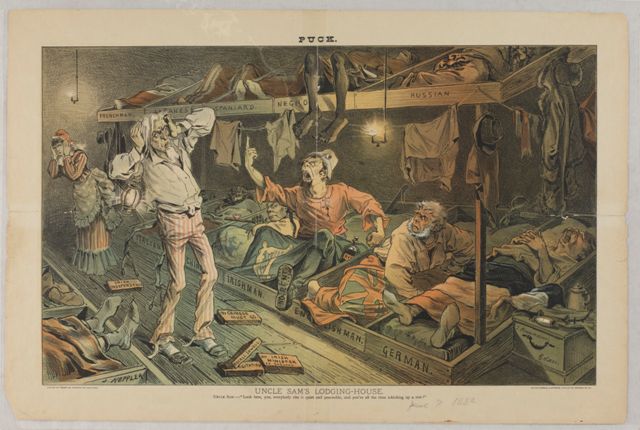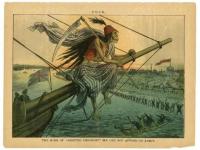Our programs here at the Historical Society allow students to work directly with primary source documents, and some of the most interesting feedback received has been through documenting students understanding of political cartoons. As a part of the HINT project here at HSP, we polled over 200 students on what they thought of political cartoons and to learn if they were a good teaching tool. The feedback we received was wonderful as many students enjoyed studying the cartoons as a part of their history lesson. It allowed students to see multiple perspectives of various historic topics -- an important aspect of the Common Core standards.
One issue, however, was when students were asked if the cartoon would be useful in a classroom or not. We found if student did not agree with the opinion of a particular cartoon, they would label it as bias, racist, or unhelpful, whereas, if they agreed with the cartoon, it was engaging, powerful, and a great teaching tool.
To further illustrate this, I was recently talking to a student about what sources she used in her National History Day project. She responded that some of the opinions she found written about her topic, Walt Disney, were negative, so she chose to ignore those sources because they were ‘biased.’ Even with the plethora of opinions that students see on a daily basis, students had a hard time understanding that all history, not just the history they do not agree with, comes with a bias, and it does not make the source unhelpful or unimportant if they do not agree with it.
For example, we have used the image above, Lincoln's Last Warning, in a wide range of classrooms from elementary through high school due to its obvious symbolism and straightforward message. Lincoln is chopping down slavery. He is physically holding an axe and swinging it toward a tree called “slavery” with a very scared human being clinging to the top. After showing students this image of Lincoln and other similar ‘pro-Northern’ ideas, I received the following feedback after asking what they thought of the cartoons:
“My favorite cartoon was Lincoln's Last Warning. This was my favorite cartoon because it had such a powerful meaning and I was able to identify the meaning behind every object in the cartoon. It was also appealing to the eye.”
“My favorite cartoon was the one with President Lincoln and the slavery tree. It was more symbolizing than the other cartoons and it was expressing that slavery was losing at the time of the Civil War.”
Also, one student mentioned that he liked the cartoons because he’s “not a racist.”
On the other side of the conversation, I showed a similar group of high school student’s cartoons that were anti-immigration, particularly against the Irish and Chinese. I used the image below, Uncle Sam's Lodging House, and received some very different remarks when asking the students if they found the images useful as a way to learn history:

“The cartoon was obviously biased but it gave me an idea of what people thought about the different ethnic groups.”
“Not really[.] They were really racist and not as educational as it should have been.”
“I think that some political cartoons can be very biased and do not effectively display the whole of a topic; however, when political cartoons do display multiple views or mentalities they can impact the viewer more than a piece of writing might.”
In the second group of responses the students were quicker to mention that the cartoons are biased or racist rather than discuss the meaning or the symbolism behind it. They also mentioned that they wanted to see different perspectives because these cartoons did not ‘display the whole of a topic.’ The first set of Civil War cartoons were clearly biased as well, yet because they agreed with the opinion they were more vocal in understanding its meaning and its ability to be an educational tool. The students were able to understand that the anti-immigration cartoons were an opinion of the past, yet they were ‘not as educational.’ It is also interesting to note that not one student called the Civil War cartoons biased.
So, how can we get students to understand that all history holds a bias from a certain viewpoint? Provide context in addition to content. Educators should ask questions such as: What were the conditions/opinions of people when this cartoon was published? How would somebody from the South feel in 1862 if they saw the image of Lincoln chopping down a tree called slavery? These questions force students to put the cartoon/historical document into perspective. It is important for students to understand that all of the cartoons they are viewing have a bias, not just the history they disagree with.
For more examples of primary sources, check out our unit plans featuring political cartoons from WWI, the Civil War, and the Progressive Era and stay tuned for a fall teacher workshop that will showcase inquiry-based learning techniques with political cartoons.

